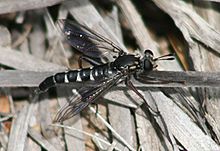- Mydas fly
-
Mydas flies 
Scientific classification Kingdom: Animalia Phylum: Arthropoda Class: Insecta Order: Diptera Suborder: Brachycera Infraorder: Asilomorpha Superfamily: Asiloidea Family: Mydidae Subfamilies - Ectyphinae
- Leptomydinae
- Mydinae
The Mydidae (alternative spelling Mydaidae), or Mydas flies, are a small (fewer than 400 species), cosmopolitan family of rather large flies - including, in fact, the largest known fly, Gauromydas heros (a.k.a. Mydas heros). Many of the species, in addition to their large size, are mimics of stinging Hymenopterans, especially wasps. They are most diverse and abundant in arid regions of the world, but can be found in other habitats. They are infrequently encountered as the adult life span appears quite short, and little is known about their biology, though larvae of some species appear to be subterranean predators of ants.
The classification of the family has changed fairly recently, with the inclusion of a few genera that were previously placed in the family Apioceridae. This had an ironic twist to it, as the apiocerids have long been given the common name "Flower-loving flies" - but the only "Flower-loving flies" that visited flowers are those which are now placed in the Mydidae. Among the flies that were transferred is the genus Rhaphiomidas, which includes one of the only Diptera on the Endangered Species List (Rhaphiomidas terminatus abdominalis, a.k.a. the "Delhi Sands flower-loving fly").
External links
Categories:- Mydidae
- Insect families
Wikimedia Foundation. 2010.
